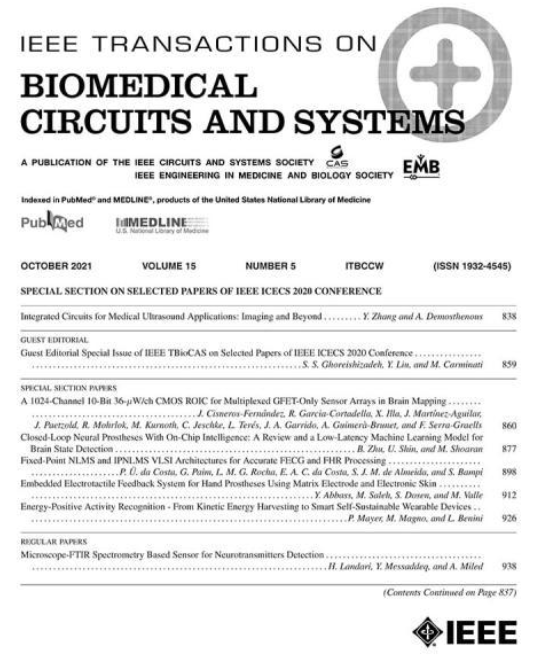用于0.18 μm CMOS的移动心电监测的410-nW高效QRS处理器
IF 4.9
2区 医学
Q2 ENGINEERING, BIOMEDICAL
IEEE Transactions on Biomedical Circuits and Systems
Pub Date : 2016-10-01
DOI:10.1109/BioCAS.2016.7833713
引用次数: 6
摘要
提出了一种低功耗、高效的QRS处理器,用于实时、连续移动心电监测。QRS检测算法是基于harr小波变换的。为了降低功耗,提出了一种优化的FIR滤波器结构。为了提高精度,设计了R位置修正(RPM)。该芯片采用0.18 μm n阱CMOS 1P6M工艺制作,在1v电压下功耗仅为410 nW,大大低于之前的工作。通过MIT-BIH心律失常数据库中48个数据库的验证,灵敏度(Se)和阳性预测(Pr)分别为99.60%和99.77%。本文章由计算机程序翻译,如有差异,请以英文原文为准。
A 410-nW efficient QRS processor for mobile ECG monitoring in 0.18-μm CMOS
This paper proposes a low power and efficient QRS processor for real-time and continuous mobile ECG monitoring. The QRS detection algorithm is based on the harr wavelet transform. In order to reduce power consumption, an optimized FIR filter structure is proposed. To improve accuracy, R position modification (RPM) has been designed. Fabricated with the 0.18-μm N-well CMOS 1P6M technology, power consumption of this chip is only 410 nW in 1 V voltage supply, which is much lower than that of previous work. Validated by all 48 databases in the MIT-BIH arrhythmia database, sensitivity (Se) and positive prediction (Pr) are 99.60% and 99.77% respectively.
求助全文
通过发布文献求助,成功后即可免费获取论文全文。
去求助
来源期刊

IEEE Transactions on Biomedical Circuits and Systems
工程技术-工程:电子与电气
CiteScore
10.00
自引率
13.70%
发文量
174
审稿时长
3 months
期刊介绍:
The IEEE Transactions on Biomedical Circuits and Systems addresses areas at the crossroads of Circuits and Systems and Life Sciences. The main emphasis is on microelectronic issues in a wide range of applications found in life sciences, physical sciences and engineering. The primary goal of the journal is to bridge the unique scientific and technical activities of the Circuits and Systems Society to a wide variety of related areas such as: • Bioelectronics • Implantable and wearable electronics like cochlear and retinal prosthesis, motor control, etc. • Biotechnology sensor circuits, integrated systems, and networks • Micropower imaging technology • BioMEMS • Lab-on-chip Bio-nanotechnology • Organic Semiconductors • Biomedical Engineering • Genomics and Proteomics • Neuromorphic Engineering • Smart sensors • Low power micro- and nanoelectronics • Mixed-mode system-on-chip • Wireless technology • Gene circuits and molecular circuits • System biology • Brain science and engineering: such as neuro-informatics, neural prosthesis, cognitive engineering, brain computer interface • Healthcare: information technology for biomedical, epidemiology, and other related life science applications. General, theoretical, and application-oriented papers in the abovementioned technical areas with a Circuits and Systems perspective are encouraged to publish in TBioCAS. Of special interest are biomedical-oriented papers with a Circuits and Systems angle.
 求助内容:
求助内容: 应助结果提醒方式:
应助结果提醒方式:


